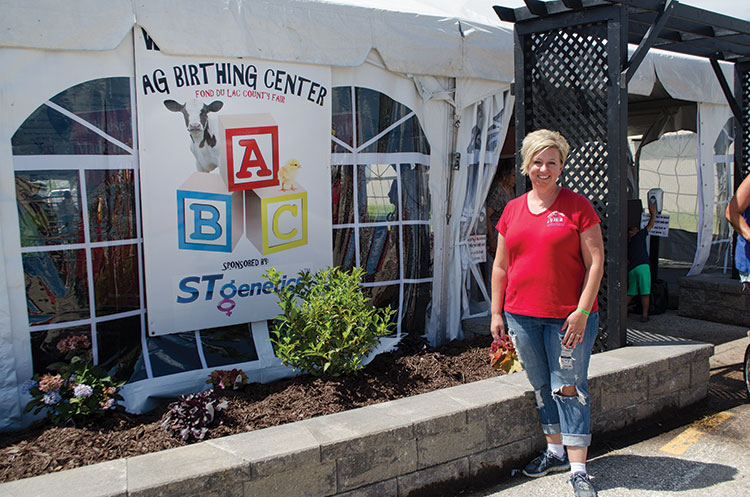
Grinstead and her husband, Grant, are partners in Vir-Clar Farms LLC in Fond du Lac, Wis., along with her parents, Gary and Rose Boyke, her brother, J.R. Boyke, and his wife, Sam. The farm milks about 2,000 cows, raises all of its calves on-site, and operates a methane digester. Grinstead previously worked in the industry before returning to the family farm to manage the calf and heifer program as well as the farm’s financial and business tasks.
With a large dairy close to town, Grinstead is often approached to host tours for farm and nonfarm audiences alike — a request she is happy to fulfill.
“I’m passionate about sharing our ag story with our nonfarm friends,” she said.
Bring on the masses
Grinstead said she most enjoys sharing her farm with youth to get them excited about agriculture and exposed to modern farms at a young age. That’s where her idea for the Vir-Clar Fall Festival took root.
The event, which takes place every other year, drew a crowd of 1,100 people in two days in 2015. In 2017, it took place September 22 and 23. Families are taken on horse-drawn wagon rides to see the whole farm, including the barns, calf hutches, methane digester, and milking parlor where they can watch their milk being produced. Fall Festival also features a small petting zoo, pony rides, and face painting. Families can purchase pumpkins to decorate, and the corn box — a sandbox filled with corn grain — is a giant hit with young guests. Local ag ambassadors and 4-H clubs operate food stands during the event as well.
Grinstead charges a small admission fee to cover the costs, and all of the remaining profits are donated to local charities. She’s able to limit her expenses with the help of 10 to 15 volunteers. She also requests sponsorships and participation from the farm’s vendors. Grinstead said that’s one of the keys to success when planning an on-farm event — engage others to lend a hand.
“You can’t be good at everything,” she said, “so don’t be afraid to ask for help.”
At the fair
Grinstead took her passion to a new audience four years ago when she started the Ag Birthing Center at the Fond du Lac County Fair. Attendees can get up close to many species — including cows, horses, sheep, and pigs — and watch videos of those animals giving birth. The biggest highlight is the chance to watch the live birth of a calf. Twelve cows gave birth at the 2017 fair, and all of them came from Vir-Clar Farms, located just 5 miles from the fairgrounds.
The exhibit draws an audience of 20,000 people annually. Each day, Grinstead relies on the help of a full-time manager and about 10 volunteers to educate attendees throughout the exhibit. About 20 sponsoring companies and farms contribute financial support.
Just before a cow is about to calve, the team makes an announcement on the loudspeaker to draw the mostly urban fair attendees to the exhibit. Vir-Clar’s herdsman, Joaquin Vasquez, has delivered more than 10,000 calves in his career and is always there to provide optimal care to the freshening cow. Veterinarians from local clinics volunteer every day as well.
Grinstead said, although it’s a huge undertaking, an educational exhibit like this is manageable when you make a list of priorities. She recommended starting small and making it a goal to add something new every year. Form a committee to delegate responsibilities, and reach out to agricultural companies in your area and brainstorm potential ways to partner with those businesses. Finally, think through all possible emergency scenarios you can, and make sure your team understands the action plan in case something goes wrong. She said quick action demonstrates your care for the animals, which is exactly what consumers want to see.
The Ag Birthing Center isn’t Grinstead’s only responsibility at the fair. She’s in her third year serving as president of the fair board. Her three kids are also beginning their showring careers, exhibiting calves, hogs, and other projects.
Beyond the barns
Outside of the fair, she is active in the Fond du Lac Charity Club, a group of 30 ladies who fund-raise to provide milk for needy children. Until Grinstead joined the group two years ago, it never had a farmer member. Grinstead also hosts about 35 farm tours annually for school groups, youth recreation programs, and even foreign guests.
Grinstead said she loves to be a resource and answer any questions she can about dairy farming. She said her number one goal is to teach people that it doesn’t matter whether milk comes from a small farm or a large farm, or whether it’s produced organically or conventionally. All milk is safe, antibiotic-free, and healthy. Consumers can be sure of that.
For some, Grinstead’s list of dairy education projects may seem daunting. She said her secret to success is knowing what she loves to do and focusing on those projects. For example, she doesn’t have the desire to be a blogger, so she doesn’t envision taking her dairy message to the blogosphere any time soon.
What she loves is giving tours and talking face-to-face with consumers, so she is always thinking of new opportunities to do just that.
“To me, it’s where my passion lies,” she said.
Grinstead reminded it’s also the simple things that can go a long way in reaching consumers. Making sure the lawn is mowed, the farm is tidy, and roads are kept clean are some of the best ways to make a good impression in the local community. Proactively building good relationships with your neighbors is also important. After that, Grinstead encourages fellow producers to think about what they love to do and how they might use those passions to share agriculture’s positive story.
She said, “Do what you can to make a difference.”





